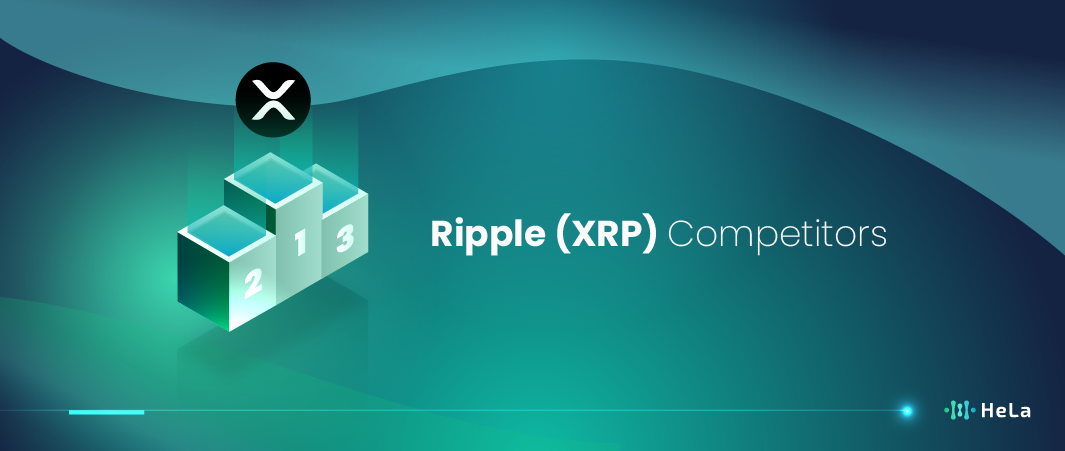In the ever-evolving world of cryptocurrency, Ripple (XRP) has established itself as a major player, known for its quick transaction speeds and cross-border payment solutions. However, as the crypto market grows, several alternatives are emerging, challenging Ripple’s dominance. In 2024, these competitors are not just attempting to match Ripple’s offerings but are striving to surpass them by addressing the needs of modern crypto users in innovative ways. This article explores the 10 best Ripple (XRP) competitors and alternatives in 2024, providing a deep dive into the future of digital finance.
We will look beyond just the names, understanding the unique propositions and advancements each competitor brings to the table.
Understanding Ripple (XRP) and Its Unique Position in the Market

Ripple (XRP) distinguishes itself in the crowded cryptocurrency market primarily through its focus on improving international money transfers. Unlike the majority of cryptocurrencies that are designed as a digital alternative to traditional currencies, Ripple’s main aim is to enhance the efficiency, speed, and cost-effectiveness of cross-border transactions. Here’s a more detailed context:
The Ripple Network and XRP
- RippleNet: Ripple’s network, RippleNet, is a real-time gross settlement system (RTGS), currency exchange, and remittance network. Unlike many cryptocurrencies that operate on a decentralized blockchain, RippleNet offers a more centralized approach. This design choice is intentional to foster trust and compliance with financial institutions.
- XRP Ledger: The XRP Ledger is an open-source blockchain technology that underpins the XRP cryptocurrency. It provides a fast and energy-efficient mechanism for transactions, contrasting sharply with the energy-intensive process seen in Bitcoin’s network.
Target Audience – Financial Institutions
- While most cryptocurrencies target individual users, Ripple primarily aims to serve banks and financial institutions. The RippleNet platform is designed to integrate with banks’ existing infrastructures, making it an attractive tool for these institutions to improve their cross-border payment operations.
Transaction Efficiency
- Ripple boasts high transaction speeds and low costs. Transactions on the Ripple network are settled in a matter of seconds and at a fraction of the costs associated with traditional banking systems and even some other cryptocurrencies. This efficiency is a core aspect of Ripple’s value proposition.
Compliance and Regulation
- Ripple has been proactive in working with financial regulators and institutions, striving to comply with various international banking laws. This approach is somewhat different from the typical cryptocurrency ethos of decentralization and avoidance of regulatory oversight. However, it’s this very approach that makes Ripple a favored choice among financial institutions.
Controversies and Legal Battles
- Ripple has faced its share of controversies, particularly with the U.S. Securities and Exchange Commission (SEC), which has impacted its reputation and the trading of XRP in certain markets. The SEC’s claim that XRP is a security, not a currency, has led to ongoing legal debates.
Competition in the Market
- The rise of other blockchain technologies and cryptocurrencies focusing on payment solutions and cross-border transfers, like Stellar (XLM), Litecoin (LTC), and others, presents significant competition. These competitors often offer similar benefits in terms of transaction speed and cost, targeting the same market inefficiencies that Ripple addresses.
Innovative Technology Integration
- Ripple continues to innovate, exploring technologies like smart contracts (through Flare Networks) and decentralized finance (DeFi) integrations to expand its capabilities and market reach.
Understanding Ripple’s unique position involves recognizing its targeted approach towards financial institutions, its compliance efforts, and the innovative technology underlying its platform. Despite facing significant competition and regulatory challenges, Ripple’s distinct focus on transforming international money transfers has set it apart in the cryptocurrency market.
The Top 10 Ripple (XRP) Competitors and Alternatives

When discussing the top competitors and alternatives to Ripple (XRP), it’s important to consider various factors such as their technology, market adoption, use cases, and overall potential impact on the digital payments and blockchain industry. Ripple, with its focus on facilitating cross-border payments and financial transactions through its RippleNet and XRP cryptocurrency, faces competition from a range of projects and platforms offering similar solutions or targeting adjacent markets. Here are some notable contenders:
1. HeLa (HLUSD)
As a relatively new entrant in the blockchain space, HeLa aims to differentiate itself by focusing on innovative solutions. HeLa is a Layer-1 blockchain solution, focusing on real-world adoption. It’s designed for scalability, security, and modularity, supporting features like EVM compatibility, decentralized digital identity, and asset integration.
Notably, HeLa uses a stablecoin for transaction fees, aiming for stability and lower costs. The project collaborates with A*STAR IHPC encourages community involvement and innovation.
2. Stellar (XLM)
Stellar positions itself as a platform designed to connect banks, payment systems, and individuals quickly and reliably. It facilitates low-cost, cross-border transactions, similar to Ripple. Stellar’s native currency, Lumens (XLM), is used to facilitate multi-currency transactions and provide liquidity.
The network emphasizes minimizing transaction costs and reducing transaction times, making financial services more inclusive, especially in underbanked regions of the world.
3. Ethereum (ETH)
Ethereum is much more than a payment technology; it’s a platform for decentralized applications (DApps). Its robust smart contract functionality allows developers to create a wide range of applications, from games to complex financial services. Ethereum’s continuous innovations and upgrades aim to improve scalability, security, and sustainability, which keep it at the forefront of blockchain technology.
The platform’s strong developer community and the vast ecosystem of DApps contribute significantly to its competitive stance against Ripple and other blockchain networks.
4. Algorand (ALGO)
Algorand focuses on speed, immediate transaction finality, and security, all while being carbon-negative. It aims to solve the blockchain trilemma by offering a platform that is decentralized, scalable, and secure.
Algorand’s Pure Proof of Stake (PPoS) consensus mechanism allows high throughput and low transaction fees, making it an attractive platform for a wide range of applications, including financial services, DeFi, and more.
5. Decentraland (MANA)
Decentraland is a virtual reality platform powered by the Ethereum blockchain. Users can create, experience, and monetize content and applications in this virtual world. The platform enables users to purchase virtual land in the form of non-fungible tokens (NFTs), which they can develop to create unique experiences.
As a pioneer in the blockchain-based virtual reality space, Decentraland offers a unique proposition that transcends traditional financial applications, potentially impacting Ripple’s market.
6. Chainlink (LINK)
Chainlink is a decentralized oracle network that aims to connect smart contracts with real-world data. It plays a critical role in the blockchain ecosystem by providing reliable, tamper-proof inputs and outputs for complex smart contracts on any blockchain.
Chainlink’s ability to securely bring external data onto blockchain networks broadens the potential use cases for smart contract technology, making it an integral part of the blockchain infrastructure that supports a variety of industries.
7. Cardano (ADA)
Cardano is distinguished by its commitment to a research-first approach, prioritizing peer-reviewed scientific research in its blockchain development process. This focus on academic rigor and formal methods in protocol development aims to ensure that the platform is secure, scalable, and sustainable.
Cardano’s gradual and methodical rollout of features, such as smart contracts and decentralized applications, reflects its commitment to building a solid, lasting foundation.
8. Solana (SOL)
Solana is known for its exceptional transaction speeds and scalability, thanks to its unique Proof of History (PoH) consensus combined with the underlying Proof of Stake (PoS) consensus. The platform supports a wide range of decentralized apps (DApps), DeFi projects, and crypto-currencies.
Its capability to process tens of thousands of transactions per second at low cost makes it a formidable competitor to Ripple, especially in scenarios where transaction throughput and speed are crucial.
9. Aave (AAVE)
Aave is a decentralized finance protocol that allows people to lend and borrow crypto. Lenders earn interest by depositing digital assets into specially created liquidity pools. Borrowers can then use their crypto as collateral to take out a flash loan using this liquidity.
Aave has been a frontrunner in the DeFi space, introducing several innovative features, such as uncollateralized loans, “rate switching,” and more, which enhance its value proposition in the evolving financial landscape.
10. Cosmos (ATOM)
Cosmos aims to address some of the hardest problems facing the blockchain industry. Its vision is to make it easy for developers to build blockchains and break the barriers between blockchains by allowing them to transact with each other. The project’s focus on interoperability is crucial for the long-term viability and success of the crypto ecosystem, enabling different networks to communicate and transact seamlessly.
The project’s emphasis on creating a decentralized network of blockchains (the ‘Internet of Blockchains’) could provide a more versatile and robust infrastructure compared to Ripple’s more singular payment-focused solution, potentially transforming how blockchains interact and scale.
These projects represent a wide spectrum of approaches and solutions in the blockchain and cryptocurrency space. While Ripple (XRP) has established itself as a significant player, especially in the cross-border payments sector, these competitors and alternatives offer diverse functionalities ranging from DeFi and smart contracts to virtual reality and blockchain interoperability. As the blockchain industry continues to evolve, the dynamics between these projects and Ripple are likely to shape the future of digital finance and blockchain technology.
Also Read: 10 Top Sei Network Competitors & Alternatives in 2024
The Evolving Landscape of Cryptocurrency: Beyond Payment Systems

The evolving landscape of cryptocurrency extends far beyond its early conception as merely a digital alternative to traditional currencies. Initially centered around payment systems like Bitcoin, the realm of cryptocurrency has expanded dramatically, paving the way for an intricate ecosystem of financial services built upon blockchain technology. This transformation signifies a shift from the initial focus on currencies like Bitcoin and Ripple, which were primarily seen as payment and remittance solutions, to a more complex and multifaceted arena.
Key drivers of this evolution are innovations such as smart contracts and decentralized finance (DeFi) platforms. Smart contracts, self-executing contracts with the terms of the agreement directly written into code, have introduced a new layer of functionality and automation to blockchain technology. They have become foundational in executing complex financial transactions, enforcing agreements, and ensuring a high level of security without the need for intermediaries.
DeFi platforms take this a step further by reconstructing and reimagining traditional financial services like lending, borrowing, and trading in a decentralized, blockchain-based environment. These platforms offer a transparent, accessible, and efficient alternative to the conventional financial system, often characterized by bureaucracy and centralization. Users are drawn to DeFi for its potential to provide more inclusive financial services, its efficiency in processing transactions, and its promise of yielding higher returns compared to traditional banking products.
The result of these advancements is a diversification of the cryptocurrency market. Where once the industry was dominated by a few major players focusing on payment systems, it now boasts a rich tapestry of platforms and services catering to various financial needs. This diversification indicates a significant shift from a one-size-fits-all approach, where each cryptocurrency attempted to solve multiple problems, to a more nuanced, service-specific market. In this evolved market, users have the liberty to choose from a plethora of options, each offering unique features and catering to different aspects of the financial ecosystem.
This evolution reflects the growing recognition of blockchain technology’s potential, not just as a tool for creating digital currencies, but as a fundamental building block for a new, decentralized digital economy. The landscape of cryptocurrency is thus not only evolving but also maturing, marking a significant leap towards its potential role in shaping the future of finance.
Factors to Consider When Choosing a Ripple Alternative
When considering a Ripple alternative, it’s important to weigh multiple factors that align with your specific needs, whether you’re an individual user or a business. Here’s a breakdown of these considerations:
- Transaction Speed: Speed is critical, especially for businesses that require real-time or near-real-time transactions. An alternative with faster processing times can be more appealing, reducing delays in cross-border transactions and enhancing overall efficiency.
- Transaction Fees: Cost is always a consideration. Lower transaction fees can significantly impact the bottom line, especially for businesses with a high volume of transactions. Individuals might also prefer platforms that offer minimal fees to maximize the value of their transfers.
- Scalability: The ability of the platform to handle growth in transaction volume is crucial. A scalable solution ensures that as your business grows or as the number of individual transactions increases, the platform can handle this growth without performance degradation.
- Financial Services Offered: The range of services provided by the platform can be a decisive factor. For businesses, services like cross-border payments, asset exchanges, liquidity provision, or even smart contract capabilities might be necessary. Individual users might look for ease of currency conversion, user-friendly interfaces, or integration with banking services.
- Security and Compliance: Ensuring that the platform adheres to regulatory standards and offers robust security measures is essential to protect financial assets and personal information.
- Integration Capabilities: For businesses, the ease with which the platform integrates with existing financial systems and processes can be a significant factor. Seamless integration can reduce operational complexities and costs.
- User Experience: For both businesses and individual users, the ease of use of the platform, the clarity of the user interface, and the overall user experience can greatly influence the choice. A platform that is easy to navigate and conduct transactions on can save time and reduce errors.
- Support and Reliability: The level of customer support offered and the platform’s historical uptime and reliability can influence the decision. Regular updates, active support, and a track record of reliable performance can instill confidence in users.
- Reputation and Trust: The track record and reputation of the platform can play a significant role. Platforms with a history of stability, positive user feedback, and industry recognition may be preferred.
Choosing a Ripple alternative is not just about finding a similar service but about identifying a platform that aligns with your specific needs and priorities in terms of speed, cost, scalability, services offered, and other critical factors. It’s a decision that should be made after careful consideration of these varied aspects to ensure that the platform you choose adds value to your business or personal financial transactions.
The Future of Cryptocurrencies and Ripple’s Place in It
The landscape of cryptocurrencies is rapidly evolving, characterized by technological advancements, regulatory shifts, and changing market demands. In this context, Ripple’s position in the market is not just contingent on its current capabilities, such as its transaction speed or cost-effectiveness. Instead, it hinges on its capacity to navigate and shape this fluid environment.
Ripple, known for its real-time settlement system, currency exchange, and remittance network, has established itself as a key player, particularly in cross-border payments. However, the future promises to be more complex and competitive. Cryptocurrencies and blockchain technology are increasingly being integrated into mainstream finance, prompting traditional financial institutions to innovate and adapt. This integration opens up new opportunities but also introduces challenges in terms of regulatory compliance, security, and market acceptance.
As the market grows, Ripple’s ability to stay at the forefront will depend on several factors:
- Innovation: Continuous technological enhancement to improve transaction speeds, reduce costs, and ensure robust security measures will be crucial. Beyond these, exploring new applications of its technology in areas like smart contracts or decentralized finance (DeFi) could provide a competitive edge.
- Regulatory Engagement: Navigating the complex and evolving regulatory landscape is paramount. Engaging proactively with policymakers and regulators to shape favorable regulatory frameworks and ensure compliance can solidify Ripple’s standing and open up new markets.
- Partnerships and Network Expansion: Strengthening existing partnerships and forging new ones can enhance Ripple’s network effect. Collaboration with banks, fintech firms, and even non-financial players can lead to innovative use cases and market expansion.
Also Read: What is Stack Mobile? A Detailed Usage Guide
- Market Adaptation: Understanding and responding to market needs, including customer and business preferences, will be vital. This involves not just reacting to the market but anticipating changes and being a step ahead.
- Community and Ecosystem Development: Building a strong, engaged community and a supportive ecosystem of developers, businesses, and users can fuel adoption and innovation.
While Ripple has made significant strides in the cryptocurrency space, its future, much like the broader landscape of digital currencies, is not set in stone. It will depend on its ability to continuously evolve, innovate, and navigate the complex interplay of technology, regulation, and market dynamics. The path ahead is as challenging as it is exciting, and Ripple’s journey will be one to watch for anyone interested in the future of finance and technology.
Conclusion
The world of cryptocurrencies is much more than just a collection of digital currencies. It’s a rapidly evolving ecosystem of financial services, with each player, including Ripple, constantly innovating to meet the changing needs of users. The 10 Ripple (XRP) competitors and alternatives highlighted in this article offer a glimpse into the future of digital finance.
From Ethereum’s smart contract functionality to Cosmos’s interoperability solutions, each competitor brings something unique to the table. As we move further into 2024, the cryptocurrency landscape is set to become more diverse, providing users with an array of options tailored to their specific financial needs. Whether you’re a business looking for efficient cross-border payment solutions or an individual seeking a user-friendly cryptocurrency, understanding the evolving market dynamics and the offerings of each competitor is key to making informed decisions in the world of digital finance.
Disclaimer: The information provided by HeLa Labs in this article is intended for general informational purposes and does not reflect the company’s opinion. It is not intended as investment advice or recommendations. Readers are strongly advised to conduct their own through research and consult with a qualified financial advisor before making any financial decisions.

Joshua Soriano
I am Joshua Soriano, a passionate writer and devoted layer 1 and crypto enthusiast. Armed with a profound grasp of cryptocurrencies, blockchain technology, and layer 1 solutions, I've carved a niche for myself in the crypto community.
-
Joshua Soriano#molongui-disabled-link
-
Joshua Soriano#molongui-disabled-link
-
Joshua Soriano#molongui-disabled-link
-
Joshua Soriano#molongui-disabled-link

